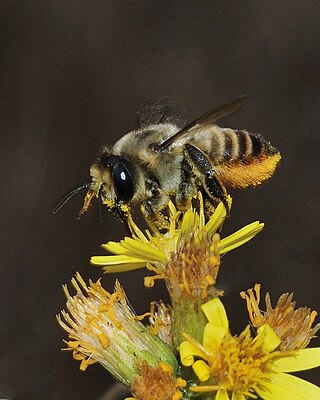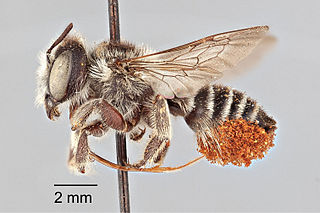
Megachile rotundata, the alfalfa leafcutting bee, is a European bee that has been introduced to various regions around the world. As a solitary bee species, it does not build colonies or store honey, but is a very efficient pollinator of alfalfa, carrots, other vegetables, and some fruits. Because of this, farmers often use M. rotundata as a pollination aid by distributing M. rotundata prepupae around their crops. Each female constructs and provisions her own nest, which is built in old trees or log tunnels. Being a leafcutter bee, these nests are lined with cut leaves. These bees feed on pollen and nectar and display sexual dimorphism. This species has been known to bite and sting, but it poses no overall danger unless it is threatened or harmed, and its sting has been described as half as painful as a honey bee's.

Megachilidae is a cosmopolitan family of mostly solitary bees. Characteristic traits of this family are the restriction of their pollen-carrying structure to the ventral surface of the abdomen, and their typically elongated labrum. Megachilid genera are most commonly known as mason bees and leafcutter bees, reflecting the materials from which they build their nest cells ; a few collect plant or animal hairs and fibers, and are called carder bees, while others use plant resins in nest construction and are correspondingly called resin bees. All species feed on nectar and pollen, but a few are kleptoparasites, feeding on pollen collected by other megachilid bees. Parasitic species do not possess scopae. The motion of Megachilidae in the reproductive structures of flowers is energetic and swimming-like; this agitation releases large amounts of pollen.

Sabal is a genus of New World palms. Currently, there are 17 recognized species of Sabal, including one hybrid species.

The Sapygidae are a family of solitary kleptoparasitic aculeate wasps. They are generally black wasps, similar in appearance to some Tiphiidae or Thynnidae, with white or yellow markings developed to various degrees.

The genus Megachile is a cosmopolitan group of solitary bees, often called leafcutter bees or leafcutting bees; it also includes the called resin bees and mortar bees. While other genera within the family Megachilidae may chew leaves or petals into fragments to build their nests, certain species within Megachile neatly cut pieces of leaves or petals, hence their common name. This is one of the largest genera of bees, with more than 1500 species in over 50 subgenera. The alfalfa leafcutter bee is managed on a commercial scale for crop pollination, and has been introduced by humans to various regions around the world.

Sabal etonia, commonly known as the scrub palmetto is a species of palm. It is endemic to Florida in the United States, where it is found in Florida sand pine scrub communities.

Conradina etonia is a rare species of shrub in the mint family known by the common name Etonia rosemary. It is endemic to Putnam County, Florida, where it is known from about 8 populations on Etoniah Creek State Forest containing fewer than 1000 total individuals. It has a specific habitat requirement and the main threat it faces is destruction and degradation of its habitat. It is a federally listed endangered species of the United States.

Sabal miamiensis, the Miami palmetto, is a rare plant species endemic to Dade County, Florida, in the vicinity of the city of Miami.

Megachile campanulae, known as the bellflower resin bee, is a species of bee in the family Megachilidae. Described in 1903, these solitary bees are native to eastern North America. Studies in 2013 placed them among the first insect species to use synthetic materials for making nests. They are considered mason bees, which is a common descriptor of bees in several families, including Megachilidae. Within the genus Megachile, frequently also referred to as leafcutter bees, M. campanulae is a member of the subgenus Chelostomoides, which do not construct nests from cut leaves, but rather from plant resins and other materials. Females lay eggs in nests constructed with individual cell compartments for each egg. Once hatched, the eggs progress through larval stages and subsequently will overwinter as pupae. The bees are susceptible to parasitism from several other bee species, which act as brood parasites. They are medium-sized bees and the female adults are typically larger than the males. They are important pollinators of numerous native plant species throughout their range.
Megachile angelarum is a species of bee in the Megachilidae family.
Megachile abacula is a species of bee in the Megachilidae family.
Megachile zombae is a species of bee in the Megachilidae family. Natively endemic to Malawi and identified in 1977, these are solitary bees. The name derives from Greek mega 'large' + cheil- (χειλ) 'lip' and a district Zomba, in Malawi.

Megachile addenda is a species of bee in the family Megachilidae. It was described by Ezra Townsend Cresson in 1878. It is a pollinator of cranberries, nesting in sand beds.

Megachile gentilis is a species of bee in the family Megachilidae. It was described by Cresson in 1872.

Megachile macularis is a species of bee in the family Megachilidae. It was described by Karl Wilhelm von Dalla Torre in 1896.It is commonly known as the leafcutter bee, is a fascinating solitary bee species renowned for its distinctive behaviors and ecological significance. Belonging to the Megachilidae family, these bees are recognized for their remarkable leaf-cutting activities, where they use mandibles to meticulously cut circular or oval pieces from leaves. Unlike honeybees, they are solitary in nature, constructing individual nests in natural cavities or human-made structures. Megachile macularis plays a crucial role in pollination, contributing to the reproduction of numerous plant species. Their unique nesting habits and efficient pollination make them essential contributors to ecosystem health and biodiversity.

Megachile melanophaea is a species of leaf-cutter bee in the family Megachilidae. It was first described by the British zoologist Frederick Smith in 1853. It is native to North America.

Megachile oenotherae is a species of bee in the family Megachilidae. It was described by Mitchell in 1924.
Megachile umatillensis is a species of bee in the family Megachilidae. It was described by Mitchell in 1927.














